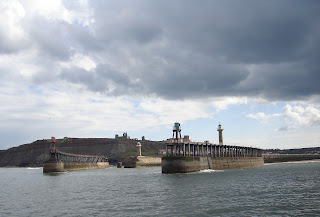Chris and Helen at Urban Reef
.
.
We took a stroll along Boscombe Pier, which can be seen in the background of the picture above. The original steel lattice pier fell into disuse and was rebuilt in concrete in the early 1960s, and fully restored a few years ago.
Boscombe sea front from the pier
.
.
We enjoyed a lovely meal in a pub in Burley in the New Forest that night, and the next day Helen drove us to the Pubeck Hills and the Jurassic Coast.
Much of the land in the Purbecks is used by the Army for firing practice and military manoeuvres. Here a group of young officers is schooled in tactical route-finding in the landscape.
.
.
Chris and Helen descend the steep path to Durdle Door
.
.
Looking down from the path
Durdle Door
.
.
Helen and Chris on the cliff top above Durdle Door
A well earned drink at the 'Square & Compass' after a strenuous walk down
to Winspit and back
.
.
If there's a steam railway in the area, I have to visit it! Helen drove us to Swanage and while the girls had a look around the town I had a ride on the railway up to Norden. Here's our Great Western pannier tank 'with the bag in' (taking water from the column).
Swanage station
On the Swanage turntable, rebuilt Bullied West Country pacific, 'Eddystone'
Corfe Castle, near Norden, the northern terminus of the line
At Norden, Standard Class 4 tank 80104 was on a low loader about to go to
the Bodmin & Wenford railway
That evening we went to Poole Quay where there was a gathering
of about 2,000 motorbikes.
Some of the bikes at Poole Quay
.
.
An immaculate NSU Quickly
.
.
A pleasant pub on the cliffs near Boscombe was the venue for our meal that evening, Helen's boyfriend Alex having joined us at Poole.
Next morning was our last day, so we asked Helen if we could visit somewhere east of Bournemouth so we'd be 'on the way home'. She led the way to Furzey Gardens in the New Forest, an ideal choice.
The house and cafe at Fursey Gardens, in the New Forest
.
.
Fursey is probably at its most colourful in Spring, and on a beautiful day
like this is seen at its best
There's a resident, and friendly, ginger cat at Fursey who loves to greet visitors!
Helen, a keen photographer, photographs Chris by the lilly pond
.
.
A view across Fursey's lilly pond
.
.
Helen took us to a local pub in the Forest where we had lunch before saying our farewells. then Helen headed west, home to Bournemouth, and we hit the long road north back to Cheshire.
What a fantastic few days... We'll be back!
.

















































